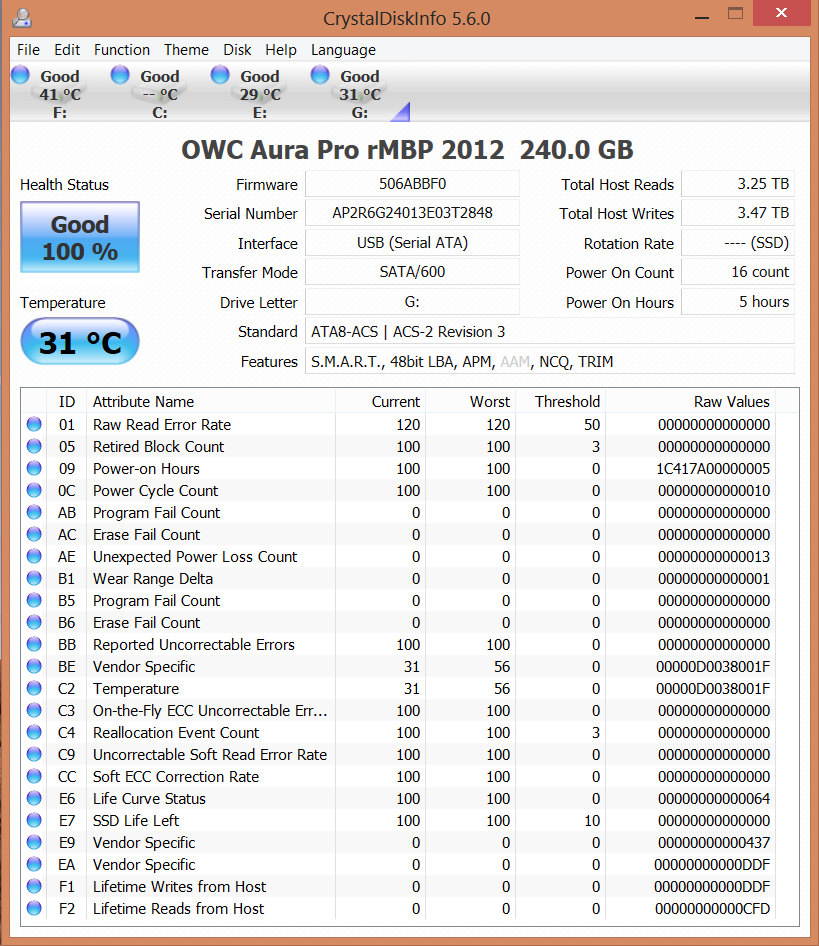Crystal Disk Info provides some excellent information about the SSD itself to include its health, product information, ‘power on’ information as well as the characteristics of the SSD. We can see that the SSD is capable of TRIM as it is not greyed out as with AAM. Typical of SF based drives, we have a very detailed depiction of the S.M.A.R.T. attributes and we can also see that we weren’t the first review source to receive this unit; Total Host Reads and Writes confirms this.
ATTO Disk Benchmark is perhaps one of the oldest benchmarks going and is definitely the main staple for manufacturer performance specifications. ATTO uses RAW or compressible data and, for our benchmarks, we use a set length of 256mb and test both the read and write performance of various transfer sizes ranging from 0.5 to 8192kb. Manufacturers prefer this method of testing as it deals with raw (compressible) data rather than random (includes incompressible data) which, although more realistic, results in lower performance results.
We have displayed the ATTO result in USB 3.0 on the right with that of USB 2.0 on the left. Clicking on any of our charts or photos will bring up a high resolution image.
Specifications for the Envoy Pro EX describe typical LSI SandForce speeds up to 500MB/s which we have yet to see in a USB3 device, mainly because the USB bridge always seems to have a bottle neck. Although our transfer speed highs 0f 315MB/s read and 345MB/s write are the highest we have seen yet from a single USB3.0 enclosure, these are still lower than literature describing LSI SandForce speeds above 500MB/s read and write.
CRYSTAL DISK BENCHMARK VER. 3.0 X64
Crystal Disk Benchmark is used to measure read and write performance through sampling of raw (0/1 Fill/compressible) or random data which is, for the most part, incompressible. Once again, we are displaying USB 3.0 on the right and USB 2.0 results on the left.

 Our CDM testing shows that USB 3.0 surpasses that of USB 2.0 performance by close to ten times. The USB 3.0 result on the left is an absolutely amazing result for any device plugged into the system solely by USB 3.0.
Our CDM testing shows that USB 3.0 surpasses that of USB 2.0 performance by close to ten times. The USB 3.0 result on the left is an absolutely amazing result for any device plugged into the system solely by USB 3.0.
 The SSD Review The Worlds Dedicated SSD Education and Review Resource |
The SSD Review The Worlds Dedicated SSD Education and Review Resource | 

Very strange that USB 2.0 would make the 4K result so much slower compared to the 4K results on USB 3.0
Theoretically, 30 MB/s at 4K should be no problem with USB 2.0 either. How can we explain this behaviour ? Maybe the bridge chip used is at fault ?
I still think 4K at speeds of 30 MB/s through USB 2.0 should be possible provided the underlying SSD supports those speeds.
Excellent review !